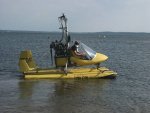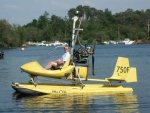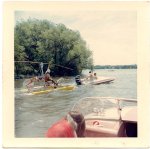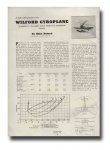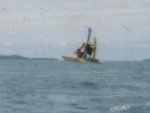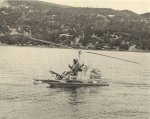You are using an out of date browser. It may not display this or other websites correctly.
You should upgrade or use an alternative browser.
You should upgrade or use an alternative browser.
Bensen On Floats
- Thread starter drleon
- Start date
MikeBoyette
Gold Member
- Joined
- Oct 30, 2003
- Messages
- 3,449
- Location
- Plant City, Fl
- Aircraft
- Dominator
- Total Flight Time
- 200+
Bad idea unless you plan on towing a gyro glider behind a boat. Ever notice you never see any gyros on floats? Thats because gyros are already pitch sensitve enough without that added drag below the CG to screw things up even more. I suggest if you want something that flys off water get a fw ultralight with pontoons. Just a suggestion. Gyros should never be put on floats too dangerous.
KenSandyEggo
Platinum Member
- Joined
- Mar 29, 2004
- Messages
- 3,657
- Location
- Charlotte, NC
- Aircraft
- McCulloch J2
- Total Flight Time
- approx. 1400+
Floats are good to help the resue squad find you hanging upside down in the water. Paint the bottoms safety orange if you do it.
Rehan K.Janjua
Gold Member
- Joined
- Sep 23, 2005
- Messages
- 1,558
- Location
- Rawalpindi-Pakistan
- Aircraft
- AirCommand 582
- Total Flight Time
- 1200hrs
I have seen Bensen's on floats and Mr Bensen himself at the controls.
I guess he could only do that, because have never seen any other gyro on floats.
Magni SA (Mr. Eric Torr) had some thing in his mind but don't know what happened, as Magni does not have any adverse pitch related problems.
I would agree with Mike.
Seasonal Greetings and best wishes.
Rehan Janjua
I guess he could only do that, because have never seen any other gyro on floats.
Magni SA (Mr. Eric Torr) had some thing in his mind but don't know what happened, as Magni does not have any adverse pitch related problems.
I would agree with Mike.
Seasonal Greetings and best wishes.
Rehan Janjua
Timchick
Tim Chick
- Joined
- Sep 15, 2004
- Messages
- 10,894
- Location
- Panama City, Florida
- Aircraft
- Sport Copter Vortex, 582 Greyhead
- Total Flight Time
- ~30
SportCopter offers floats as an option and their new video shows Jim Vaneck taking off and landing on the water.
Here's some photos that were on one of the european sites.
Here's some photos that were on one of the european sites.
Attachments
eclipse
Member
- Joined
- Mar 17, 2005
- Messages
- 16
- Location
- Vinterbro/Norway
- Aircraft
- Pitbull/Tornado/bumble bee/Ela/Xenon
- Total Flight Time
- 80
Pitbull (N.A.R) had floats as option.
I have a Pitbull and with the tractor configuration an long stable body i think that should work.
I think to by Krucker floats thats intended for trike www.4kru.com.
Any comment.
I have a Pitbull and with the tractor configuration an long stable body i think that should work.
I think to by Krucker floats thats intended for trike www.4kru.com.
Any comment.
KenSandyEggo
Platinum Member
- Joined
- Mar 29, 2004
- Messages
- 3,657
- Location
- Charlotte, NC
- Aircraft
- McCulloch J2
- Total Flight Time
- approx. 1400+
Half us dummies, including me, have had a hard time keeping them upright on firm to the ground wheels.
gyroplanes
FAA DAR Gyropilot
- Joined
- Mar 18, 2004
- Messages
- 6,207
- Aircraft
- (1) Air Command, (1) Bensen glider project (1) Air Command 2 place kit, (1) Sycamore gyro
- Total Flight Time
- 2650
MikeBoyette said:Ever notice you never see any gyros on floats?
I have to differ with you Mike.
Years ago the PRA magazine was full of gyros on floats, and they were flying! It was a very common practice to build and fly float equipped gyros. It was a lot easier to find a lake to tow on than it was a suitable runway.
There is an issue of the PRA magazine, from years ago, that had pictures of more gyros on floats than on wheels!
We even had a guy in Wisconsin that stuck his 447 Air Command on a set of Hobie Cat pontoons, he said it needed more horsepower (Duh!). I understand his wife was fast taxiing it and hit a boat, destroying it.
I talked to the owner of a float equipped Air Command in the Pacific Northwest. He told me that the bulk of his floats are aft of the center of gravity and act more like a stabilizer than a de-stabilizer.
I'm certaily not an aeronautical engineer, I doubt anyone on the forum is, I don't recommend attempting a major modification of this kind on a pusher gyro.
I just don't want to ignore the facts. Pusher & tractor gyroplanes HAVE successfully been flown on floats.
Attachments
SamL
Senior Member
- Joined
- May 19, 2005
- Messages
- 312
- Location
- Melbourne Australia
- Aircraft
- GT Gyroplanes "KRUZA" G-762
- Total Flight Time
- 700+
The only gyro I would consider maybe trying floats on would be a full length Little Wing.
Even then I would EEEEERRRR on the side of safety.
Regards Sam.
Even then I would EEEEERRRR on the side of safety.
Regards Sam.
Attachments
Timchick
Tim Chick
- Joined
- Sep 15, 2004
- Messages
- 10,894
- Location
- Panama City, Florida
- Aircraft
- Sport Copter Vortex, 582 Greyhead
- Total Flight Time
- ~30
That 3rd picture looks like an early tall tail.
I don't think the water spray would do a wooden prop any good.
I've seen what it does to an Ivoprop on a Searay, and that prop is a good bit higher up than a gyro prop.
And tougher too.
I've seen what it does to an Ivoprop on a Searay, and that prop is a good bit higher up than a gyro prop.
And tougher too.
Doug Riley
Platinum Member
- Joined
- Jan 11, 2004
- Messages
- 6,983
The fact that Bensen and various other people have gotten float-equipped pusher gyros up and back down again in one piece does not prove they are safe. The rotor can mask the built-in PPO tendency until the right combination of high power setting and low G un-cages this killer beast.
One of my old PRA chapter-mates, Harlan Gage, flew a Bensen float gyro as both a towed glider and free-flying gyrocopter. He eventually had a serious crash from what sounds like a drag-over -- the machine tucked nose-down and just flew into the water.
OTOH, there's no reason on paper that a safe float gyro can't be built. It just shouldn't be built by simply bolting floats onto a stock land model. You need to know the aerodynamic forces created by the floats at various airspeeds and angles of attack. That is, treat the float as you would an airfoil, developing lift and drag curves for it by actual testing.
Once you have a numerical handle on these forces, you can get to work on tail surfaces that are truly powerful enough to contain these forces. Even then, it would be prudent to work with large-scale models in a real or simulated wind, before building the real thing.
My guess is that a tractor would be much more practical than a pusher in this case.
One of my old PRA chapter-mates, Harlan Gage, flew a Bensen float gyro as both a towed glider and free-flying gyrocopter. He eventually had a serious crash from what sounds like a drag-over -- the machine tucked nose-down and just flew into the water.
OTOH, there's no reason on paper that a safe float gyro can't be built. It just shouldn't be built by simply bolting floats onto a stock land model. You need to know the aerodynamic forces created by the floats at various airspeeds and angles of attack. That is, treat the float as you would an airfoil, developing lift and drag curves for it by actual testing.
Once you have a numerical handle on these forces, you can get to work on tail surfaces that are truly powerful enough to contain these forces. Even then, it would be prudent to work with large-scale models in a real or simulated wind, before building the real thing.
My guess is that a tractor would be much more practical than a pusher in this case.
From: Cierva Autogiros by Peter W. Brooks:
“Cierva C.30A Rota seaplane. (140 hp Armstrong Siddeley Civet 1). Following test-flying by Cierva and Marsh from the River Medway at Rochester between April 13 and 26, 1935, Marsh ferried the Rota seaplane (K4296) mounted on Short F.60 type twin floats from Rochester to Felixstowe. At Felixstowe, this aircraft was tested for the Air Ministry at the Marine Aircraft Experimental Establishment. During these tests, Marsh had a most unpleasant experience. On the evening of April 29 he started a test dive at about 6,000 ft (1500 m) and at 110-115 mph (188-185 km/hr) suddenly experienced a violent nose-down pitching moment that he was unable to arrest with the control column. The machine bunted onto its back and Marsh found himself flying upside-down at 3,000 ft (900 m) with the rotor below him. At this point some lead ballast in the front cockpit fell out of the aircraft, fortunately missing the revolving blades as it passed through the rotor disc. The machine then righted itself of its own accord and Marsh, who had meanwhile switched off the engine, force-landed on the open sea immediately beneath. He climbed onto a float, swung the propeller, and taxied back to Filixstowe. An eyewitness recorded that Marsh’s only comment when he reached the slipway after this ordeal was “When’s the next blankety-blank train back to London?”
“Cierva C.30A Rota seaplane. (140 hp Armstrong Siddeley Civet 1). Following test-flying by Cierva and Marsh from the River Medway at Rochester between April 13 and 26, 1935, Marsh ferried the Rota seaplane (K4296) mounted on Short F.60 type twin floats from Rochester to Felixstowe. At Felixstowe, this aircraft was tested for the Air Ministry at the Marine Aircraft Experimental Establishment. During these tests, Marsh had a most unpleasant experience. On the evening of April 29 he started a test dive at about 6,000 ft (1500 m) and at 110-115 mph (188-185 km/hr) suddenly experienced a violent nose-down pitching moment that he was unable to arrest with the control column. The machine bunted onto its back and Marsh found himself flying upside-down at 3,000 ft (900 m) with the rotor below him. At this point some lead ballast in the front cockpit fell out of the aircraft, fortunately missing the revolving blades as it passed through the rotor disc. The machine then righted itself of its own accord and Marsh, who had meanwhile switched off the engine, force-landed on the open sea immediately beneath. He climbed onto a float, swung the propeller, and taxied back to Filixstowe. An eyewitness recorded that Marsh’s only comment when he reached the slipway after this ordeal was “When’s the next blankety-blank train back to London?”
karlbamforth
Newbie
- Joined
- Nov 2, 2005
- Messages
- 1,336
- Location
- Langkawi, Malaysia
- Aircraft
- Fixed wing/ rotary
- Total Flight Time
- 500+
How does a gyro fly upside down without destroying itself ?
Maybe those anti-droop cables help support the blades while inverted.
Can't be many gyro or heli pilots survived such an incident.
Maybe those anti-droop cables help support the blades while inverted.
Can't be many gyro or heli pilots survived such an incident.
With gyroplanes such as the RAF-2000 and early AirComand without horizontal stabilizers and with a large offset between propeller thrust line and center of mass, the tumbling acceleration (torque/moment of inertia) upon loss of rotor thrust is so great the rotor enters precession stall and the airframe runs into its own rotor.
It is my speculation the Cierva C-30, with massive horizontal stabilizer providing damping, inverted slowly enough that the rotor could follow without stalling. The rotor obviously had enough kinetic energy to keep it going until the machine recovered. The entire sequence occupied perhaps 5 seconds. The C-30 did not have droop cables.
In any event, Marsh was damned lucky.
It is my speculation the Cierva C-30, with massive horizontal stabilizer providing damping, inverted slowly enough that the rotor could follow without stalling. The rotor obviously had enough kinetic energy to keep it going until the machine recovered. The entire sequence occupied perhaps 5 seconds. The C-30 did not have droop cables.
In any event, Marsh was damned lucky.
Attachments
Cobra Doc
Senior Trouble Maker
- Joined
- Oct 13, 2004
- Messages
- 1,787
- Location
- Carrollton, GA
- Aircraft
- Senior Telemaster, Schluter Moskito
- Total Flight Time
- 25,000 instrument approaches
Anybody happen to take a look at the German machine that inspired Mr. Benson? Towed by a submarine and equipped with floats. So what if it had a couple of thousand horsepower pulling it? It was doable with 1930s technology!
RHerron
Senior Member
Floats
Floats
Cody,
Towing a gyro with floats isn't the same as free-flight with floats. The tow cable exerts a stabilizing force that isn't present in free-flight. That's why it is so important to have a lot of tail surface.
The German "Wagtail" didn't operate with floats anyway, it was reeled back onto the submarine's surface and folded up and stowed.
Floats
Cody,
Towing a gyro with floats isn't the same as free-flight with floats. The tow cable exerts a stabilizing force that isn't present in free-flight. That's why it is so important to have a lot of tail surface.
The German "Wagtail" didn't operate with floats anyway, it was reeled back onto the submarine's surface and folded up and stowed.
Similar threads
- Replies
- 33
- Views
- 1K
- Replies
- 5
- Views
- 675

